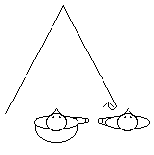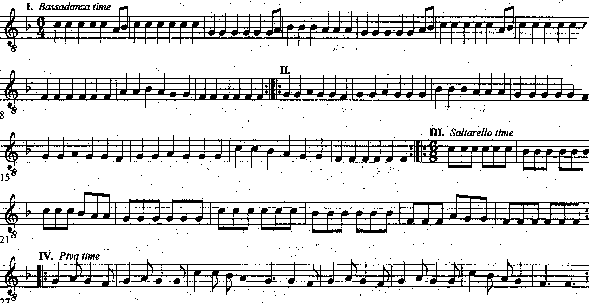Starting Position
(Man and Woman are now 8 steps apart, facing each other.)

Bars 8-10
(End side by side, facing up the hall, Man on left, holding hands.)
| Steps: | Sempio (in 6), Doppio (in 4 and 6), Saltarello (in 6), Ripresa (in 6), Movimento, Mezavolta, Volta del Gioioso. | Starting Position |
| Start: | Side by side, facing up the hall, holding hands, Woman on the right. | |
| [Introduction of two bars on accompanying tape.] | ||
| 1-2 | Ripresa Left, Ripresa Right. Drop hands. | |
| 3-5 | Man Sempio Left, Sempio Right, Doppio Left, Doppio Right ending with Mezavolta Right. (Man and Woman are now 8 steps apart, facing each other.) | |
| 6-7 | Both Ripresa Left, Ripresa Right. | |
| 8-10 | Man returns with Sempio Left, Sempio Right, Doppio Left, Doppio Right ending with a Mezavolta Right, and taking hands. (Man and Woman are side by side again, Woman on the right.) | |
| 1-10 (2nd time) | Repeat, but Woman leaves and returns, instead. |  Bars 8-10 |
| 11-12 | Ripresa Left, Ripresa Right. | |
| 13-16 | Both Sempio Left, Sempio Right, Doppio Left, Doppio Right, Doppio Left. Drop hands. | |
| 17-18 | Volta del Gioioso, then take hands. | |
| 11-18 (2nd time) | Repeat. | |
| 19-26 (twice) | 16 Saltarelli, starting on the Left. Drop hands. | |
| 27 | Man Movimento. | |
| 28 | Woman Movimento. | |
| 29-30 | Man Doppio Left. | |
| 31 | Woman Movimento. | |
| 32 | Man Movimento. | |
| 33-34 | Woman Doppio Left up to Man. | |
| 27 (2nd time) | Man Movimento. | |
| 28 (2nd time) | Woman Movimento. | |
| 29-30 (2nd time) | Man Doppio Right. | |
| 31 (2nd time) | Woman Movimento. | |
| 32 (2nd time) | Man Movimento. | |
| 33-34 (2nd time) | Woman Doppio Right up to Man. Take hands. (End side by side, facing up the hall, Man on left, holding hands.) | |
Teaching Notes
In Bar 10 the man's mezavolta will cause him to lose eye contact with the woman. If the dancers do not like this, see the note for Bar 10 below.
Recordings
Forse - Two-note introduction. Works with this reconstruction. Repeats.
Mesura - Four-bar introduction. Works with this reconstruction. Repeats.
Music Leonardo - Three-bar introduction. Works with this reconstruction. Repeats.
Musica XV - Two-bar introduction. The first ten bars thereafter are quieter, and sound like an introduction, but aren't. Nice and lively. In between Section I and II there are twenty extra bars. One solution is to repeat Section I over again, (both times); the music isn't the same, but the number of bars is correct. Section III is rather fast, and it may be easier to drop the saltarelli to half speed and only do eight (in 4/4 style) of them. The dance is not repeated.
Sonare - No introduction. Works with this reconstruction. Repeats.
Dance Notes
The dance is called Rostiboli, Gioioso, or Rostiboli Gioioso (with varying spellings) in different sources. There is also a three-person version by Guglielmo.
The Sc version starts with the saltarello section, then has Section IV, and ends with the bassadanza sections, which are first in all the other versions. This may be a mistake, but it is notable that many balli start with a section of piva or saltarello, and that Roti Boully Joyeulx from the Brussels manuscript starts with the pas de Brebant, which is equivalent to saltarello.
The version in NYp is slightly different, resulting in the leading person always being on the left side. It is possible that the dance was always meant to be that way and only NYp described it clearly, but we have treated it like a different version. The differences are outlined in Bar 10 and Bars 27-34 (2nd time) below.
 NYp version showing Man's path in Bars 3-5 and Bars 8-10 |
Bars 8-10: PnA and PnG do not indicate that the man returns to the woman, and it is possible that in that version the man travels even further from the woman, instead. She would then catch up with her two sets of two sempii and two doppii. As there is no turn, the riprese done while the partners are separate would have the woman facing the man's back, and this seems unlikely. The other sources all specify that he is to return to her, and we chose to do so, as it produces a more interesting dance.
Bar 10: When the man does his mezavolta right, at the end of the bar, he is turning his back on his partner, which is liable to be disturbing to some dancers. A solution for this is to have the man do his mezavolta backwards, pivoting counterclockwise on his right foot, which will allow him to maintain eye contact.
The alternate version from NYp does not have this problem as the man goes to the right-hand side of the woman (literally "mano di sotto"). Although it isn't specified, she presumably returns to her place on the right side when she does this part.
Bars 11-12 (2nd time): NYp states that these riprese are presi, and Sc calls for only one ripresa here. The instructions given in PnA are for a repeat of the steps done before, and the music is also exactly repeated, so there seems no reason to use faster, or only one, riprese.
Bar 27-34 (2nd time): Aside from NYp, the sources either say to repeat this section, presumably identically, or, in the case of Fn and Fl, specify identical steps. The only problem with this is that, if the dance is repeated, the dancers are then on the wrong foot to start over. For the sources that do not mention a repeat it may be that a repeat was not customary, so this was not a problem. However Fn and Fl do both say a repeat is to be done, and still have the last doppio on the left. We decided to change this last doppio to the right foot.
The only change we made is in Bars 29-30, where the man is actually instructed to end his doppio by putting his left foot forward, turning toward the woman. This leaves him ready to step again on the right, but since our movimento is done ending with weight on both feet, this is unnecessary, so we simplified it to a normal doppio ending with a mezavolta.
| 27 (2nd time) | Man Movimento. |  Alternate NYp version of Bars 33-34 (2nd time) 28 (2nd time) | Woman Movimento. | 29-30 (2nd time) | Man Doppio Right, ending with a Mezavolta Right. | (The dancers are looking at each other, Man facing down the hall.) 31 (2nd time) | Woman Movimento. | 32 (2nd time) | Man Movimento. | 33-34 (2nd time) | Woman Doppio Right, turning as she reaches Man, as Man Doppio Right, meeting Woman. Take hands. | (End side by side, Woman on the left, facing down the hall, holding hands.) |
Music Notes

We omitted an apparently-supurfluous rest in Bar 5. At the beginning of Bar 11 we omitted an extra F (following Sparti's suggestion).
In the saltarello section, 15 bars of music (7.5 repeated) are given but the choreography calls for 16 bars. We have added the final 3 notes of the section, in keeping with the general pattern of the music for this dance. In the section immediately following, we deleted the opening minima (which was perhaps meant as a pickup from the previous section).
The last section is apparently in piva time, and should be played more quickly than the saltarello section (also transcribed in 6/8). In this section, as in Petit Riense, two bars of music correspond to one doppio.